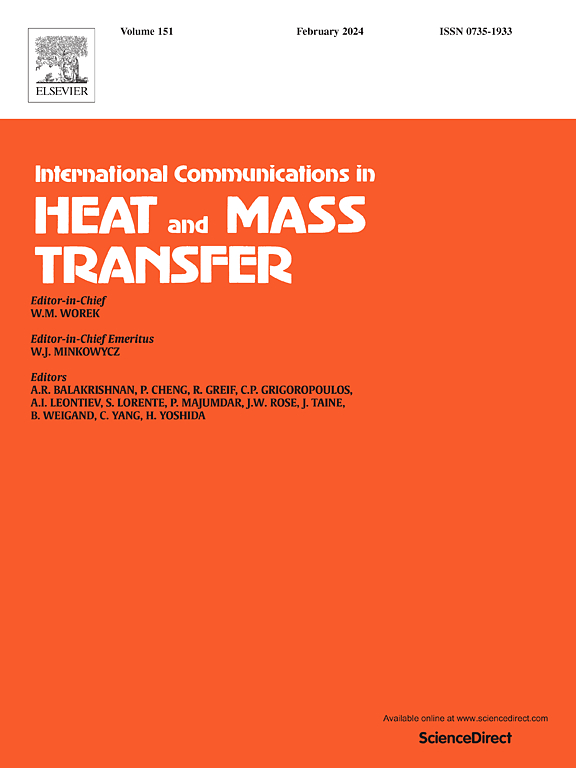交错截断鳍片式微通道热交换器的热流体力学性能研究
IF 6.4
2区 工程技术
Q1 MECHANICS
International Communications in Heat and Mass Transfer
Pub Date : 2024-11-11
DOI:10.1016/j.icheatmasstransfer.2024.108202
引用次数: 0
摘要
本研究制定了具有交错和截断鳍片的矩形微通道,并对其进行了数值模拟。分析了交错距离、翅片角度和翅片高度对整体性能的影响。结果发现,增大交错距离可显著降低压降,同时增强热性能,且呈先增大后减小的趋势。这可能是由于交错翅片引起的扰动,促进了流线的分流,并通过改善冷热流体的混合而增强了传热。增大翅片角度可提高热性能,同时导致压降显著增加。增加翅片高度可提高热效率和流动阻力,当翅片上端存在一定间隙时,热效率最高。随后,RSM 进一步研究了这三个参数的影响。结果表明,参数对传热和整体性能的影响呈先增后减的趋势。通过优化参数,发现最佳组合为 L=0.18mm、A=42.5°、H=0.16mm,在 Re=416 时实现了最大 PEC 值 1.33。本文章由计算机程序翻译,如有差异,请以英文原文为准。
Investigation on the thermohydraulic performance of a microchannel heat exchanger incorporating staggered truncated fins
A rectangular microchannel featuring staggered and truncated fins was formulated and numerically simulated in this study. The influence of stagger distance, fin angle, and fin height on overall performance was analyzed. The phenomenon was obtained that increasing the stagger distance could significantly decrease the pressure drop, while enhancing the thermal behavior with an initially increase and then decrease trend. This can be ascribed to the disturbance induced by the staggered fins, promoting the diversion of flowlines and enhancing heat transfer through improved blending of hot and cold fluids. Increasing the fin angle can increase thermal performance while simultaneously leading to a significant increase in pressure drop. Increasing the fin height resulted in greater thermal enhancement and flow resistance, with the maximum thermal enhancement observed when there is a certain gap at the upper end of the fins. Subsequently, the effects of these three parameters were further investigated by RSM. The results indicated that the impact of the parameters on heat transfer and overall performance followed an increasing-then-decreasing trend. By optimizing the parameters, the best combination was found to be , , , and the maximum of 1.33 was achieved at .
求助全文
通过发布文献求助,成功后即可免费获取论文全文。
去求助
来源期刊
CiteScore
11.00
自引率
10.00%
发文量
648
审稿时长
32 days
期刊介绍:
International Communications in Heat and Mass Transfer serves as a world forum for the rapid dissemination of new ideas, new measurement techniques, preliminary findings of ongoing investigations, discussions, and criticisms in the field of heat and mass transfer. Two types of manuscript will be considered for publication: communications (short reports of new work or discussions of work which has already been published) and summaries (abstracts of reports, theses or manuscripts which are too long for publication in full). Together with its companion publication, International Journal of Heat and Mass Transfer, with which it shares the same Board of Editors, this journal is read by research workers and engineers throughout the world.

 求助内容:
求助内容: 应助结果提醒方式:
应助结果提醒方式:


